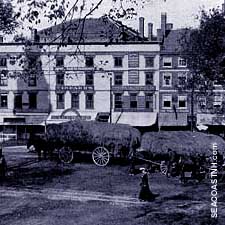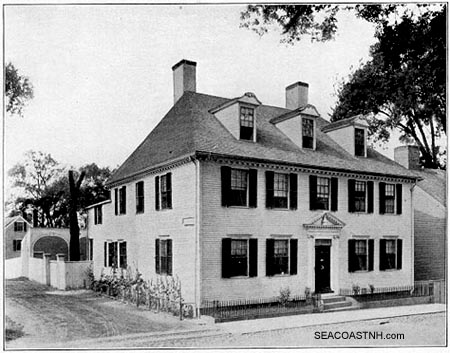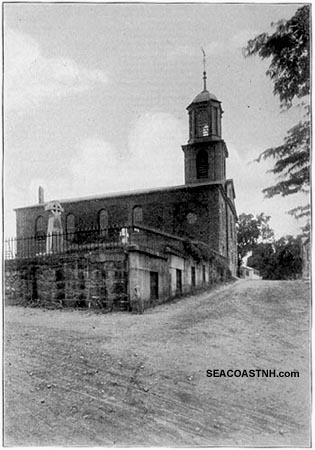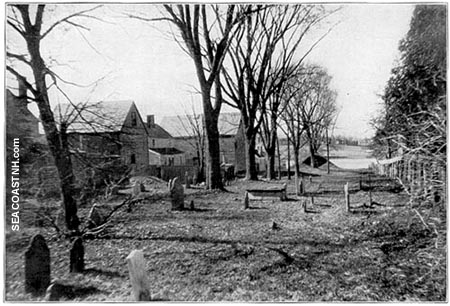|
FRESH STUFF DAILY |
|
|
||
|
|
||
|
|
||
|
SEE ALL SIGNED BOOKS by J. Dennis Robinson click here |
||
In Chapter 3 of his nostalgic visit to Portsmouth, Aldrich offers this extraordinary view. No author of his time more clearly draws the reader into life in the Victorian seaport, mixing his historic tour with lively character tales and observations. We’ve added a pix from the 1893 edition.
CHAPTER THREE: A STROLL ABOIUT TOWN READ Chapter Two As you leave the river front behind you, and pass "up town," the streets grow wider, and the architecture becomes more ambitious -- streets fringed with beautiful old trees and lined with commodious private dwellings, mostly square white houses, with spacious halls running through the centre. Previous to the Revolution, white paint was seldom used on houses, and the diamond-shaped window pane was almost universal. Many of the residences stand back from the brick or flagstone sidewalk, and have pretty gardens at the side or in the rear, made bright with dahlias and sweet with cinnamon roses. If you chance to live in a town where the authorities cannot rest until they have destroyed every precious tree within their blighting reach, you will be especially charmed by the beauty of the streets of Portsmouth. In some parts of the town, when the chestnuts are in blossom, you would fancy yourself in a garden in fairyland. In spring, summer, and autumn the foliage is the glory of the fair town -- her luxuriant green and golden tresses! Nothing could seem more like the work of enchantment than the spectacle which certain streets in Portsmouth present in midwinter after a heavy snowstorm. You may walk for miles under wonderful silvery arches formed by the overhanging and interlaced boughs of the trees, festooned with a drapery even more graceful and dazzling than springtime gives them. The numerous elms and maples which shade the principal thorough fares are not the result of chance, but the ample reward of the loving care that is taken to preserve the trees. There is a society in Portsmouth devoted to arboriculture. It is not unusual there for persons to leave legacies to be expended in setting out shade and ornamental trees along some favorite walk. Richards Avenue, a long, unbuilt thoroughfare leading from Middle Street to the South Burying-Ground, perpetuates the name of a citizen who gave the labor of his own hands to the beautifying of that wind swept and barren road to the cemetery. This fondness and care for trees seems to be a matter of heredity. So far back as 1660 the selectmen instituted a fee of five shillings for the cutting of timber or any other wood from off the town common, excepting under special conditions. In the business section of the town trees are few. The chief business streets are Congress and Market. Market Street is the stronghold of the dry - goods shops. There are seasons, I suppose, when these shops are crowded, but I have never happened to be in Portsmouth at the time. I seldom pass through the narrow cobble paved street without wondering where the customers are that must keep all these flourishing little establishments going. Congress Street -- a more elegant thoroughfare than is Market -- is the Nevski Prospekt of Portsmouth. Continue OLD TOWN BY THE SEA
Among the prominent buildings is the Athenaeum, containing a reading-room and library. From the high roof of this building the stroller will do well to take a glance at the surrounding country. He will naturally turn seaward for the more picturesque aspects. If the day is clear, he will see the famous Isles of Shoals, lying nine miles away -- Appledore, Smutty-Nose, Star Island, White Island, etc.; there are nine of them in all. On Appledore is Laighton's Hotel, and near it the summer cottage of Celia Thaxter, the poet of the Isles. On the northern end of Star Island is the quaint town of Gosport, with a tiny stone church perched like a sea-gull on its highest rock. A mile southwest from Star Island lies White Island, on which is a lighthouse. Mrs. Thaxter calls this the most picturesque of the group. Perilous neighbors, O mariner! in any but the serenest weather, these wrinkled, scarred, and storm-smitten rocks, flanked by wicked sunken ledges that grow white at the lip with rage wllen the great winds blow! How peaceful it all looks off there, on the smooth emerald sea! and how softly the waves seem to break on yonder point where the unfinished fort is! That is the ancient town of Newcastle, to reach which from Portsmouth you have to cross three bridges with the most enchanting scenery in New Hampshire lying on either hand. At Newcastle the poet Stedman has built for his summerings an enviable little stone chateau -- a seashell into which I fancy the sirens creep to warm themselves during the winter months. So it is never without its singer. Opposite Newcastle is Kittery Point, a romantic spot, where Sir William Pepperell, the first American baronet, once lived, and where his tomb now is, in his orchard across the road, a few hundred yards from the "goodly mansion" he built. The knight's tomb and the old Pepperell House, which has been somewhat curtailed of its fair proportions, are the objects of frequent pilgrimages to Kittery Point. From this elevation (the roof of the Athenaeum) the navy yard, the river with its bridges and islands, the clustered gables of Kittery and Newcastle, and the inimitable ocean beyond make a picture worth climbing four or five flights of stairs to gaze upon. Glancing down on the town nestled in the foliage, it seems like a town dropped by chance in the midst of a forest. Among the prominent objects which lift themselves above the tree tops are the belfries of the various churches, the white facade of the custom house, and the mansard and chimneys of the Rockingham, the principal hotel. The pilgrim will be surprised to find in Portsmouth one of the most completely appointed hotels in the United States. The antiquarian may lament the demolition of the old Bell Tavern, and think regretfully of the good cheer once furnished the wayfarer by Master Stavers at the sign of the Earl of Halifax, and by Master Stoodley at his inn on Daniel Street; but the ordinary traveler will thank his stars, and confess that his lines have fallen in pleasant places, when he finds himself among, the frescoes of the Rockingham. Obliquely opposite the doorstep of the Athenaeum -- we are supposed to be on terra firma again -- stands the Old North Church, a substantial wooden building, handsomely set on what is called The Parade, a large open space formed by the junction of Congress, Market, Daniel, and Pleasant streets. Here in days innocent of water-works stood the town pump, which on more than one occasion served as whipping-post. Continue OLD TOWN BY THE SEA
The churches of Portsmouth are more remarkable for their number than their architecture. With the exception of the Stone Church they are constructed of wood or plain brick in the simplest sty1e. St. John's Church is the only one likely to attract the eye of a stranger. It is finely situated on the crest of Church Hill, overlooking the ever-beautiful river. The present edifice was built in 1808 on the site of what was known as Queen's Chapel, erected in 1732, and destroyed by fire December 24, 1806. The chapel was named in honor of Queen Caroline, who furnished the books for the altar and pulpit, the plate, and two solid mahogany chairs, which are still in use in St. John's. Within the chancel rail is a curious font of porphyry, taken by Colonel John Tufton Mason at the capture of Senegal from the French in 1758, and presented to the Episcopal Society in 1761. The peculiarly sweet-toned bell which calls the parishioners of St. John's together every Sabbath is, I believe, the same that formerly hung in the belfry of the old Queen's Chapel. If so, the bell has a history of its own. It was brought from Louisburg at the time of the reduction of that place in 1745, and given to the church by the officers of the New Hampshire troops. The Old South Meeting-House is not to be passed without mention. It is among the most aged survivals of pre-revolutionary days. Neither its architecture nor its age, however, is its chief warrant for our notice. The absurd number of windows in this battered old structure is what strikes the passer-by. The church was erected by subscription, and these closely set large windows are due to Henry Sherburne, one of the wealthiest citizens of the period, who agreed to pay for whatever glass was used. If the building, could have been composed entirely of glass it would have been done by the thrifty parishioners. Portsmouth is rich in graveyards -- they seem to be a New England specialty -- ancient and modern. Among the old burial places the one attached to St. John's Church is perhaps the most interesting. It has not been permitted to fall into ruin, like the old cemetery at the Point of Graves. When a headstone here topples over it is kindly lifted up and set on its pins again, and encouraged to do its duty. If it utterly refuses, and is not shamming decrepitude, it has its face sponged, and is allowed to rest and sun itself against the wall of the church with a row of other exempts. The trees are kept pruned, the grass trimmed, and here and there is a rosebush drooping with a weight of pensive pale roses, as becomes a rosebush in a churchyard. Continue OLD TOWN BY THE SEA
The place has about it an indescribable soothing atmosphere of respectability and comfort. Here rest the remains of the principal and loftiest in rank in their generation of the citizens of Portsmouth prior to the revolution -- stanch, royalty-loving governors, counselors, and secretaries of the Province of New Hampshire, all snugly gathered under the motherly wing of the Church of England. It is almost impossible to walk anywhere without stepping on a governor. You grow haughty in spirit after a while, and scorn to tread on anything less than one of His Majesty's colonels or a secretary under the Crown. Here are the tombs of the Atkinsons, the Jaffreys, the Sherburnes, the Sheafes, the Marshes, the Mannings, the Gardners, and others of the quality. All around you underfoot are tumbled-in coffins, with here and there a rusty sword atop, and faded escutcheons, and crumbling armorial devices. You are moving in the very best society. This, however, is not the earliest cemetery in Portsmouth. An hour's walk from the Episcopal yard will bring you to the spot, already mentioned, where the first house was built and the first grave made, at Odiorne's Point. The exact site of the Manor is not known, but it is supposed to be a few rods north of an old well of still-flowing water, at which the Tomsons and the Hiltons and their comrades staked their thirst more than two hundred and sixty years ago. Odiorne's Point is owned by Mr. Eben L. Odiorne, a lineal descendant of the worthy who held the property in 1657. Not far from the old spring is the resting-place of the earliest pioneers." "This first cemetery of the white man in New Hampshire," writes Mr. Brewster, "occupies a space of perhaps one hundred feet by ninety, and is well walled in. The western side is now used as a burial-place for the family, but two thirds of it is filled with perhaps forty graves, indicated by rough head and foot stones. Who there rest no one now living knows. But the same care is taken of their quiet beds as if they were of the proprietor's own family. In 1631 Mason sent over about eighty emigrants many of whom died in a few years, and here they were probably buried. Here too, doubtless, rest the remains of several of those whose names stand conspicuous in our early state records." Note 1: Mr. Charles W. Brewster, for nearly fifty years the editor of the Portsmouth Journal, and the author of two volumes of local sketches to which the writer of these pages here acknowledges his indebtedness. CONTINUE to Chapter Four Please visit these SeacoastNH.com ad partners.
News about Portsmouth from Fosters.com |
| Thursday, April 25, 2024 |


|
Copyright ® 1996-2020 SeacoastNH.com. All rights reserved. Privacy Statement
Site maintained by ad-cetera graphics

 Link Free or Die
Link Free or Die






















